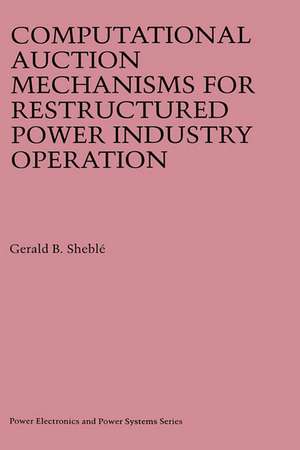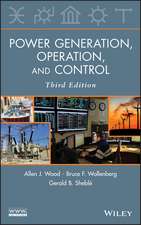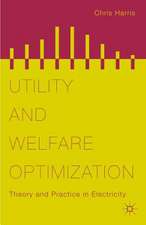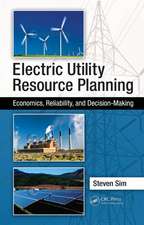Computational Auction Mechanisms for Restructured Power Industry Operation: Power Electronics and Power Systems
Autor Gerald B. Shebléen Limba Engleză Hardback – 31 mar 1999
Computational Auction Mechanisms for Restructured Power Industry Operation outlines the application of auction methods for all aspects of power system operation, primarily for a competitive environment. A complete description of the industry structure as well as the various markets now being formed is given. A thorough introduction to auction basics is included to explain how auctions have grown in other industries. Auction methods are compared to classical techniques for power system analysis, operations, and planning. The traditional applications of economic dispatch, optimal power flow and unit commitment are compared to auction mechanisms. Algorithms for auctions using linearized power flow equations, DC power flow equations, and AC power flow equations are included. The bundling of supportive services, known as ancillary services within the United States, is discussed. Extensions to the basic auction algorithms for inclusion of supportive services as well as algorithms for scheduling and bidding on generation for GENCOs or independent power producers are presented. Algorithms for scheduling and contracting with customers are also presented for energy service companies. An introduction to the various commodity and financial market products includes the use of futures and options for GENCOs. The material is useful for students performing research on the new business environment based on competition. Regulators will find information on initial methods of designing and evaluating market systems, and power exchange and financial analysts will find information on the interdependence of markets and power system-based techniques for risk management. This information compares the new business environment solutions with old business environment solutions.
Computational Auction Mechanisms for Restructured Power Industry Operation provides a first introduction to how electricity will be traded as a commodity in the future.
| Toate formatele și edițiile | Preț | Express |
|---|---|---|
| Paperback (1) | 947.67 lei 6-8 săpt. | |
| Springer Us – 12 oct 2012 | 947.67 lei 6-8 săpt. | |
| Hardback (1) | 953.65 lei 6-8 săpt. | |
| Springer Us – 31 mar 1999 | 953.65 lei 6-8 săpt. |
Din seria Power Electronics and Power Systems
- 18%
 Preț: 944.19 lei
Preț: 944.19 lei -
 Preț: 487.37 lei
Preț: 487.37 lei - 20%
 Preț: 630.01 lei
Preț: 630.01 lei - 15%
 Preț: 648.56 lei
Preț: 648.56 lei - 15%
 Preț: 643.84 lei
Preț: 643.84 lei - 18%
 Preț: 1113.89 lei
Preț: 1113.89 lei - 18%
 Preț: 1120.99 lei
Preț: 1120.99 lei - 18%
 Preț: 950.33 lei
Preț: 950.33 lei - 18%
 Preț: 1981.53 lei
Preț: 1981.53 lei - 15%
 Preț: 638.43 lei
Preț: 638.43 lei - 18%
 Preț: 1660.95 lei
Preț: 1660.95 lei - 18%
 Preț: 940.87 lei
Preț: 940.87 lei - 15%
 Preț: 637.46 lei
Preț: 637.46 lei - 18%
 Preț: 949.55 lei
Preț: 949.55 lei - 18%
 Preț: 953.97 lei
Preț: 953.97 lei - 18%
 Preț: 944.67 lei
Preț: 944.67 lei - 15%
 Preț: 634.32 lei
Preț: 634.32 lei - 18%
 Preț: 832.78 lei
Preț: 832.78 lei - 18%
 Preț: 945.30 lei
Preț: 945.30 lei - 18%
 Preț: 1239.85 lei
Preț: 1239.85 lei - 15%
 Preț: 642.18 lei
Preț: 642.18 lei - 18%
 Preț: 1656.08 lei
Preț: 1656.08 lei - 18%
 Preț: 953.65 lei
Preț: 953.65 lei - 18%
 Preț: 1554.09 lei
Preț: 1554.09 lei - 18%
 Preț: 1657.03 lei
Preț: 1657.03 lei - 18%
 Preț: 951.47 lei
Preț: 951.47 lei - 18%
 Preț: 888.31 lei
Preț: 888.31 lei - 18%
 Preț: 1219.01 lei
Preț: 1219.01 lei - 18%
 Preț: 893.53 lei
Preț: 893.53 lei - 18%
 Preț: 942.94 lei
Preț: 942.94 lei - 18%
 Preț: 1110.24 lei
Preț: 1110.24 lei - 15%
 Preț: 641.85 lei
Preț: 641.85 lei
Preț: 953.65 lei
Preț vechi: 1162.99 lei
-18% Nou
Puncte Express: 1430
Preț estimativ în valută:
182.47€ • 190.54$ • 150.68£
182.47€ • 190.54$ • 150.68£
Carte tipărită la comandă
Livrare economică 15-29 aprilie
Preluare comenzi: 021 569.72.76
Specificații
ISBN-13: 9780792384755
ISBN-10: 079238475X
Pagini: 340
Ilustrații: XIII, 340 p.
Dimensiuni: 155 x 235 x 21 mm
Greutate: 0.68 kg
Ediția:1999
Editura: Springer Us
Colecția Springer
Seria Power Electronics and Power Systems
Locul publicării:New York, NY, United States
ISBN-10: 079238475X
Pagini: 340
Ilustrații: XIII, 340 p.
Dimensiuni: 155 x 235 x 21 mm
Greutate: 0.68 kg
Ediția:1999
Editura: Springer Us
Colecția Springer
Seria Power Electronics and Power Systems
Locul publicării:New York, NY, United States
Public țintă
ResearchCuprins
1 Introduction.- 1.1 History of the Electric Industry.- 1.2 The Shift Toward Deregulation.- 1.3 Choosing a Competitive Framework.- 1.4 Preparing for Competition.- 1.5 Present Overall Problem.- 1.6 Economic Evolution.- 1.7 Market Structure.- 1.8 Fully Evolved Marketplace.- 1.9 Computerized Auction Market Structure.- 1.10 Role of Markets in Society.- 1.11 Commodity Contracts.- 1.12 Auction Market Mechanism.- 1.13 The Spot Market-Place.- 1.14 Commodity Markets.- 1.15 Commodity and Futures Trading Commission’s Regulations.- 1.16 General Exchange Regulations.- 1.17 The Energy Marketplace.- 1.18 Regulation of Pricing of Ancillary Services.- 1.19 Regulatory Questions.- 1.20 Engineering Research Problems.- 2 Industrial Infrastructure.- 2.1 Review of Deregulation.- 2.2 Auction Mechanisms.- 2.3 Evaluation and Comparison of Auction Institutions.- 2.4 Risk Aversion.- 2.5 Auctions in Industrial Markets.- 2.6 Overview of Brokerage/auction Systems.- 2.7 Schweppe’s Theory of Spot Pricing.- 3 Auction as Linear Program.- 3.1 Linear Programming.- 3.2 Basic Discrete Auctions.- 3.3 Degeneracy and Auctions as an Assignment Problem.- 3.4 More General Models.- 3.5 Vertically Integrated Industry.- 3.6 Decentralization in a Nonlinear Model.- 4 Economic Dispatch, Unit Commitment, and Optimal Power Flow as Auctions.- 4.1 Economic Dispatch.- 4.2 Unit Commitment.- 4.3 Auction Mechanism with Classical Optimization.- 4.4 Auction Formulation.- 4.5 Utilizing Interior-point Linear Programming Algorithm....- 4.6 Market Power.- 4.7 Supporting Services.- 4.8 Linear Programming or Mixed-integer Programming.- 4.9 Transmission Loss Allocation.- 5 General Operations Planning.- 5.1 General Corporate Model.- 5.2 Forecasting Demand, Markets, and Competitors.- 5.3 Multiple Product Production Frontier.- 5.4Electric Energy Industry Modeling.- 5.5 Inventory Contract Management.- 5.6 Cash Management.- 5.7 Transaction Portfolio Management.- 5.8 Risk Management.- 5.9 Futures Allocations.- 5.10 Auction Market Dynamic Simulation.- 5.11 AGC Simulator in Price-based Operation.- 5.12 Advanced Concepts.- 6 Genco Operation.- 6.1 Introduction.- 6.2 GENCO Case Studies.- 6.3 Building Fuzzy Bidding Strategies for the Competitive Generator.- 6.4 Profit-based Unit Commitment for the Competitive Environment.- 6.5 Price-based UC Results.- 6.6 Handling Uncertainty in Price and Load Forecasts.- 6.7 Improving Bidding Strategies Through Intelligent Data Mining.- 6.8 Bidding Strategies for LR Based Power Auction.- 7 Esco Operation.- 7.1 Determining Value in a Deregulated Market.- 7.2 Cost-based Load Management Using LP.- 7.3 Profit-based Load Management Using LP.- 7.4 Battery Stored Energy Control for Price-based Operation.


















